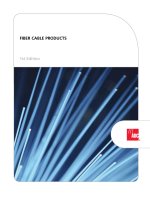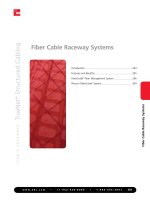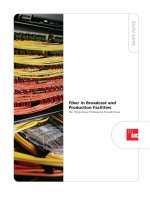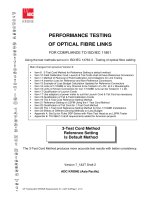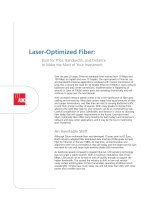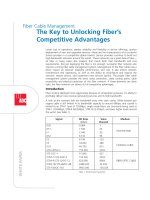Training - ADC KRONE - Introduction to Fiber Optical
Bạn đang xem bản rút gọn của tài liệu. Xem và tải ngay bản đầy đủ của tài liệu tại đây (3.04 MB, 116 trang )
1
Introduction to Optical Fiber
Anton Indrawata
Technical Manager Enterprise S.E. Asia
2
Properties and Applications of Optical Fibre
Introduction
• Optical fibre uses light waves
• LED or Laser - ON or OFF simulates digital “Ones &
Zeros”
• Fibre comprised of high purity silica glass
3
• Electrical signals in copper are compatible with
terminal equipment
• Fibre transmission uses light, which are not
compatible with terminal equipment which uses
electrical signals
• Requires to convert light to electrical - cost penalty
Properties and Applications of Optical Fibre
Electrical to Optical Conversion
4
Properties and Applications of Optical Fibre
Advantages
• Virtual total immunity to electrical noise
• Supports extremely high data rates
• Inherently safe from hazardous voltages if non-metallic
• Low transmission loss at very high data rates
• Doesn't radiate EMI
• Light weight
• Increase in distance
5
Properties and Applications of Optical Fibre
Disadvantages
• Cost of electrical to optical conversion
• Termination more costly and time consuming
• Jointing/Splicing more costly and time consuming compared
to Direct Termination
• Care in fibre handling during installation - bending and
tension
6
Properties and Applications of Optical Fibre
Fibre vs Copper
• Loss increases with high frequency transmission in copper
• Loss stays the same with high frequency transmission in
fibre
• Copper have NINETEEN (19) test parameter
• Fibre have ONE (1) test parameter (Multimode)
7
Properties and Applications Optical Fibre
Electrical Power Separations
• Copper requires installation practice for
separation/segregation from power
• Fibre does not require separation/segregation unless fibre
cable has a electrically conductive elements
• Thermal load of power cable should be considered
8
Optical Fibre Applications
Customer Premises
• Inter-LAN links within & between buildings
• In 1980’s: Backbone for FDDI, Token Ring
• Delivery of multimedia such as pay TV, video conferencing,
video imaging
• Carrier services such as Broadband ISDN, B-ISDN,
multimedia high speed data, ATM, Gigabit Ethernet, Fibre
Channels etc.
9
Optical Fibre Applications
Wavelength Division Multiplexing - WDM
• Transmitting data/video on different light wavelengths
• Combining them using diffraction grating (coupler) ,
transmission over fibre
• Separating individual wavelengths at receiver -
coupler/splitter
10
Optical Fibre Applications
Wavelength Division Multiplexing - WDM
11
Fibre Cable Types
• Tightly Buffered, Heavy Duty
• Indoor application
• 900 μm OD for each fibre
• Made around central strength member
• Kevlar strands for tensile loads
• Overall polyethylene jacket
• Maybe direct terminated
• Robust cable and termination
• Greater O/D than light duty
12
Fibre Cable Types
• Loose Tube
• Single or groups of 250 μm fibres enclosed in tubes
• Tubes made around central strength member
• Gel filled to exclude moisture
• Overall polyethylene jacket
• Used in U/G, Aerial environment
• More time consuming
13
Fibre Cable Types
Outer sheath 0.9 mm
Silicon layer 400µm
Core+Cladding+Primary coating = 250 µm
Gel
Loose
tube
Tight
Buffer
Core+Cladding+Primary coating = 250 µm
Outer sheath 1.4 mm
14
Fibre Cable Types - Tight Buffered
Optical Fibre
Tight Buffer
Aramid yarn
Single unit jacket
Outer jacket
Single fibre
Duplex fibre
15
Breakout
Duplex
Simplex
FDDI
Fibre Cable Types -Tight Buffered
16
Fibre Cable Types – Tight Buffered
Indoor Distribution
17
Fibre Cable Types – Tight Buffered
Indoor/ Outdoor, LSZH Jacket
18
Fibre Cable Types – Loose Tube
Central strength member
Optical fibres
Loose buffer tube, gel filled
Core binding tape
Inner jacket
Corrugated steel armour
Outer jacket
19
PE sheath
Fibre Cable Types - Loose Tube
Outdoor All Dielectric Non Armoured
Aramid yarn
Tube, each with up to 12 fibres
Central support element
Empty tube as filler
Gel
20
Steel Tape Armoured Type
Optical Fibres
Filling Compound
Loose Buffer Tubes
PE Filler (if necessary)
Filling Compound
Metallic CSM
CSM Over-Coat
PET Film Laminated Water Swellable Tape
Corrugated Steel Tape
Outer PE Jacket
Fibre Cable Types - Loose Tube
Outdoor Steel Tape Armored
21
Suspension Wire
Web
Optical Fibres
Filling Compound
Loose Buffer Tubes
Filler (if necessary)
Dielectric CSM
PET Film Laminated Water
Swellable Tape
Corrugated Steel Tape
Ripcord
Outer PE Jacket
Fig 8 Type
Fibre Cable Types - Loose Tube
Outdoor Aerial
22
Comparison
Tight Buffered vs Loose Tube
23
Single Fibre Construction
• When we talk about fibres being 50/125µ, 62.5/125µ or 9/125µm,
we are referring to the relationship between core and cladding
diameters.
– The core and cladding are part of the same glass or plastic rod, but
have different optical properties.
250 µm
Buffer or
Primary Coating
9 µm
50 µm
62.5 µm
Core
Core/Cladding Interface
Cladding
125 µm
Secondary
Coating
900 µm
24
Single Fibre Construction
Primary & Secondary Coating
• UV cured acrylate 250μm Outer Diameter
• Tight buffering with primary & secondary coating
900μm Outer Diameter
• Use appropriate stripping tool for removal of coating to
avoid damage to fibre
25
• Multimode fibres 50/125um and 62.5/125um
operate at 850nm & 1300nm wavelengths
• Singlemode fibre 9/125um operates at 1310nm &
1550nm are just out of the visible light spectrum
• These wavelengths are just in the infra-red region
• Cautions: Active fibre can be emitting “DARK” light,
potential health hazard
• Never look into the end of a fibre or fibre patch lead
Light Propagation in Optical Fibre


